Physics - Ch 66 Ch 4 Quantum Mechanics: Schrodinger Eqn (3 of 92) The Wave Equation
TLDRThis lecture transcript delves into the fundamental aspects of wave equations, emphasizing the necessity for any real wave equation to adhere to a generalized form. It explains how the wave function's solution must align with the generalized wave equation in one dimension, and illustrates this with a comparison to classical mechanics' general wave equation. The process of deriving the Schrödinger equation from these principles is outlined, highlighting the importance of satisfying the wave equation to ensure it accurately describes the motion of small particles in quantum mechanics. The lecture sets the stage for further exploration into the development of the Schrödinger equation in subsequent videos.
Takeaways
- 🌊 The lecture focuses on the third aspect of the wave equation, emphasizing its necessity to be a proper wave equation.
- 📈 The generalized wave equation in one dimension is introduced as a fundamental requirement for a real wave equation.
- 🌟 The wave function's solution must be in the form of y = f(t) + g(t), where f and g are functions of time and minus x over Vx, with Vx being the one-dimensional distance.
- 🔄 The wave equation must satisfy the general equation for an undamped system, which is derived from the form of sines and cosines.
- 📚 The process of comparing the generalized wave equation to a classical mechanics wave equation is discussed, using a familiar example of Y = A*cos(ωt - kx).
- 🔢 By taking partial derivatives with respect to X and T, the equation is shown to satisfy the general wave equation, confirming its validity as a proper wave equation.
- 🌐 The relationship K² = 1/V² * ω² is established, where K is the wave number and ω is the angular frequency.
- 🌀 K is defined as 2π/λ (wavelength), and ω is related to the frequency, F, demonstrating that wavelength times frequency equals velocity for any wave.
- 💡 The equation's derivation is a step towards the Schrödinger equation, which will describe the motion of small particles in quantum mechanics.
- 🚀 The final form of the Schrödinger equation is not yet presented; further modifications are required to reach the final version.
- 🎯 The historical process of deriving the Schrödinger equation involved comparing it to known wave equations and iteratively refining it to accurately describe quantum phenomena.
Q & A
What is the primary requirement for a surging equation to be considered a proper wave equation?
-A surging equation must adhere to the generalized wave equation in one dimension, which is the fundamental form of a real wave equation.
What is the general form of the wave function solution in one dimension?
-The general form of the wave function solution is y = f(t) + g(t), where f and g are functions of time and the minus sign indicates the direction of wave propagation in one-dimensional space.
How does the wave equation relate to the concept of undamped systems?
-For an undamped system, the general solution to the wave equation must take the form that satisfies the generalized wave equation without any damping factors.
What is the significance of the sine and cosine functions in wave equations?
-Sine and cosine functions are used to represent the wave equation in terms of sinusoidal waves, which are fundamental to describing oscillatory motion in physics.
How does the classical mechanics wave equation (Y = A*cos(ωt - kx)) relate to the generalized wave equation?
-The classical mechanics wave equation is a specific case of the generalized wave equation. It can be derived from the generalized form by applying partial derivatives with respect to x and t.
What happens when we take the partial derivative of the classical wave equation with respect to x?
-The partial derivative with respect to x yields a term involving the sine function and the spatial frequency (k), which is -A*k*cos(kx - ωt).
What is the result of taking the second partial derivative of the classical wave equation with respect to x?
-The second partial derivative with respect to x results in a term involving the cosine function and the square of the spatial frequency (k^2), which is -A*k^2*cos(kx - ωt).
How does the frequency (ω) relate to the velocity (v) of a wave in the context of the wave equation?
-The frequency (ω) is related to the velocity (v) by the equation ω = v*k, where k is the wave number (2π/λ) and λ is the wavelength. This relationship is derived from the wave equation and is a fundamental principle in wave physics.
What is the significance of the wavelength (λ) and frequency (f) in the context of the wave equation?
-The wavelength (λ) and frequency (f) are significant because their product equals the wave's velocity. This relationship is essential for understanding wave behavior and is used to validate the wave equation.
How does the process of deriving the Schrödinger equation relate to the development of quantum mechanics?
-The Schrödinger equation was developed to describe the motion of small particles in quantum mechanics. It was derived by starting with a generalized wave equation and adjusting it to fit the known principles of wave behavior and quantum phenomena.
What was the historical approach to deriving the Schrödinger equation?
-The historical approach to deriving the Schrödinger equation involved a process of trial and error, comparing the new equation to known wave equations, and adjusting it to accurately describe quantum mechanical phenomena.
Outlines
📚 Introduction to Wave Equations
This paragraph introduces the concept of wave equations, emphasizing the need for a proper wave equation to adhere to a generalized form. It discusses the one-dimensional generalized wave equation and its implications for solutions in the context of wave functions. The paragraph also explains how the wave equation must satisfy specific conditions for an undamped system, leading to a solution in the form of sines and cosines. The process of validating a wave equation is illustrated by comparing it to a classical mechanics wave equation and showing that it satisfies the generalized wave equation through mathematical derivation.
🌐 Wave Equations and Quantum Mechanics
The second paragraph delves into the relationship between wave equations and quantum mechanics. It explains how the general form of a wave equation can be used to derive the Schrödinger equation, which is crucial for describing the motion of small particles in the quantum world. The paragraph outlines the process of deriving a proper wave equation by comparing it to familiar classical mechanics equations and showing that it satisfies the wave equation. It also touches on the concept of wavelength and frequency in relation to velocity, highlighting the importance of these parameters in wave equations. The paragraph concludes by suggesting that the derived wave equation serves as a foundation for further development in quantum mechanics, particularly in understanding particle motion.
Mindmap
Keywords
💡Wave Equation
💡Schrodinger Equation
💡Generalized Form
💡One-Dimensional Case
💡Undamped System
💡Partial Derivative
💡Amplitude
💡Frequency
💡Wavelength
💡Velocity
💡Quantum Mechanics
Highlights
The lecture introduces the concept of a proper wave equation and its importance in understanding wave functions.
The generalized wave equation in one dimension is presented as a fundamental requirement for a real wave equation.
The solution to the wave equation must be in the form of y equals a function of time, plus a minus X over V X, where V X represents one-dimensional distance.
The general solution to the wave equation for an undamped system is discussed, highlighting the need for it to satisfy the given wave equation.
The imaginary part in the real part of the equation is noted, which leads to the equation being written in the form of sines and cosines.
The process of comparing the wave equation to a familiar classical mechanics wave equation is explained, using Y equals amplitude times the cosine of Omega T or KX minus Omega T.
The partial derivatives of the classical wave equation with respect to X and T are calculated to verify its satisfaction of the general wave equation.
The cancellation of terms in the equation when plugging in the derivatives is observed, leading to the relation K squared equals 1 over V squared times Omega squared.
The relationship K squared over Omega squared equals 1 over V squared is derived, which is a key step in validating the wave equation.
K is defined as 2 PI over lambda, and Omega as 2 pi times the frequency, leading to the conclusion that the wavelength times the frequency equals the velocity.
The equation is confirmed to be a proper wave equation because it satisfies the general form of the wave equation.
The process of deriving the Schrödinger equation from the general form of the wave equation is discussed, emphasizing the iterative nature of its development.
The lecture outlines the historical journey of physicists in deriving equations to describe the motion of small particles in quantum mechanics.
The importance of starting with a generalized solution of the wave equation to derive the Schrödinger equation is highlighted.
The lecture sets the stage for the next video, where the derivation of the Schrödinger equation and its application in quantum mechanics will be explored.
The necessity of comparing new equations to known ones to validate their correctness is emphasized, showcasing the methodological approach in physics.
The lecture concludes with a preview of the next steps in the derivation process, promising a deeper understanding of the Schrödinger equation.
Transcripts
Browse More Related Video
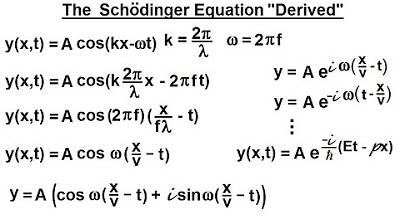
Physics - Ch 66 Ch 4 Quantum Mechanics: Schrodinger Eqn (4 of 92) The Schrodinger Eqn. "Derived"
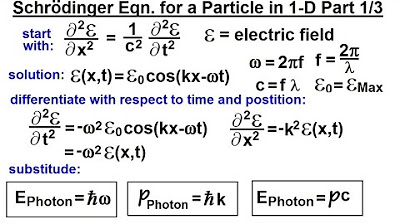
Physics - Ch 66 Ch 4 Quantum Mechanics: Schrodinger Eqn (5 of 92) The Schrodinger Eqn. in 1-D (1/3)

How Schrodinger Came Up With His Famous Equation (But EASIER)
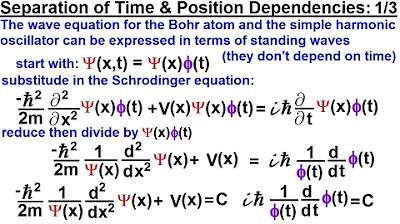
Physics - Ch 66 Ch 4 Quantum Mechanics: Schrodinger Eqn (12 of 92) Time & Position Dependencies 1/3
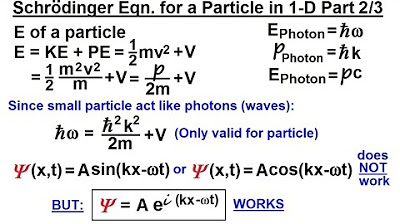
Physics - Ch 66 Ch 4 Quantum Mechanics: Schrodinger Eqn (6 of 92) The Schrodinger Eqn. in 1-D (2/3)
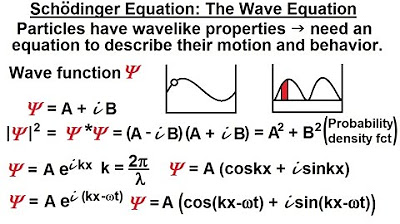
Physics - Ch 66 Ch 4 Quantum Mechanics: Schrodinger Eqn (1 of 92) The Wave Equation
5.0 / 5 (0 votes)
Thanks for rating: